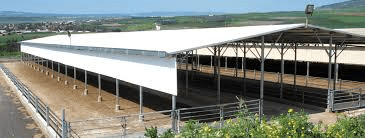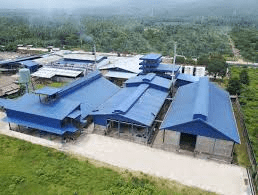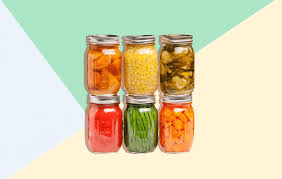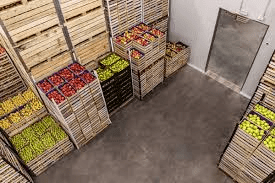It is estimated that in the tropics each year between 25 and 40% of stored agricultural products including crop products is lost because of inadequate farm and village-level storage. In the field and during storage the products are threatened by insects, rodents, birds and other pests.
Moreover, the product may be spoiled by infection from fungi, yeasts or bacteria. In addition, for sowing seed it is important that the viability (its capacity to germinate) is maintained.
In order to minimize the losses during storage it is important to know the optimum environmental conditions for storage of the product, as well as the conditions under which its attackers flourish.
Problems of Crop Storage
1. Temperature
It is of greatest importance that a roof is constructed above the silos in such a way that it extends far enough to protect the walls against full sunlight. This lowers the inside temperature, lessens temperature changes between day and night and reduces the chance of local heating, which causes condensation in other, cooler spots with consequent fungus growth.
One can also use building materials which do not easily pass on changes in outside temperatures to the stored grains (good insulators), or one can paint the containers white.
Read Also : Traditional Storage of Roots and Tubers
2. Moisture
Moisture may enter the storage container via the ground, the walls or the roof. A good overhanging roof protects the walls against rain. In order to prevent moisture coming up from the ground, the gourds, baskets, sacks etc. should always be placed on a dry underfloor or on a platform of bricks or wooden poles.
Floors of stone or concrete can be laid on a moisture barrier made of metal foil, tar paper, plastic and/or should have a waterproof layer of cement of 1 cm thickness (weight ratio water: cement: sand = 0.3:1:3).
During storage in the rainy season moisture from the air can also enter via the walls of the silo, unless this is taken into account when choosing and building the silo (airtight storage).
3. Insects
First of all it is important to keep the storage room and the surrounding area as clean as possible, especially when using a non-airtight storage method.
Put a clean product into a container, only after all old products, dust, straw and insects have been removed, and all cracks and holes have been filled and sealed.
One should distinguish between insects that are already present in the product to be stored and insects that may enter the storage room during storage.

Prevent further development of the insects by:
Airtight storage
Sunning: Insects leave grain which is placed in hot sunlight as they do not like temperatures higher than 40 – 50 °C. The sunning process, however, does not always kill eggs and larvae present inside the grain itself.
Mixing the grains with wood ash (or ash of burned rice husks), burned cow dung, fine sand, lime, diatomaceous earth or certain types of kaolin clay. Volume ratios of ash: grain = 1:1 to 1:2, and clay: grain = 1:10.
The effect of kaolin clay is greatly enhanced if sulphuric or hydrochloric acid is added and subsequently heated to 400 °C. The materials used, fill the spaces between the grains, thereby restricting insect movement and emergence.
A similar method is the admixture of small cereal grains, for example millet, with maize or sorghum. Certain vegetable oils, such as palm and groundnut oil, applied to pulses, give protection against bruchids (a kind of beetle).
Mixing local plants with the grains. In many areas, local plants are known of which the roots, leaves, flowers and/or fruits (dried and ground) act as a repellents.
4. Domestic Animals
These can be kept away by building a fence around the silo, made out of wood, bamboo or other local materials. A stack of twigs around the silo is also sufficient. Take care that it does not become a hiding place for rats.
5. Thieves
Theft is made more difficult if the fill- and outflow openings are made in such a way that they can be locked. It is also possible to construct a silo without an outflow.
Recommended Temperature and Relative Humidity, and Approximate Transit and Storage Life for Fruits and Vegetable Crops

Table: Recommended Temperature and Relative Humidity, and Approximate Transit and Storage Life for Fruits and Vegetable Crops
ProductTemperatureRelative Humidity (percent)Approximate storage life°C°FAmaranth0-232-3695-10010-14 daysAnise0-232-3690-952-3 weeksApples-1-430-4090-951-12 monthsApricots-0.5-031-3290-951-3 weeksArtichokes, globe03295-1002-3 weeksAsian pear13490-955-6 monthsAsparagus0-232-3595-1002-3 weeksAtemoya135585-904-6 weeksAvocados, Fuerte, Hass74585-902 weeksAvocados, Lula, Booth-144090-954-8 weeksAvocados, Fuchs, Pollock135585-902 weeksBabaco74585-901-3 weeksBananas, green13-1456-5890-9514 weeksBarbados cherry03285-907-8 weeksBean sprouts03295-1007-9 daysBeans, dry4-1040-5040-506-10 monthsBeans, lima , in pods5-641-43955 daysBeets, bunched03298-10010-14 daysBeets, topped03298-1004-6 monthsBelgian endive2-336-3895-9824 weeksBitter melon12-1353-5585-902-3 weeksBlack sapote13-1555-6085-902-3 weeksBlackberries-0.5-031-3290-952-3 daysBlood orange4-740-4490-953-8 weeksBlueberries-0.5-031-3290-952 weeksBok choy03295-1003 weeksBoniato13-1555-6085-904-5 monthsBreadfruit13-1555-6085-902-6 weeksBroccoli03295-10010-14 daysBrussels sprouts03295-1003-5 weeksCabbage, early03298-1003-6 weeksCabbage, late03298-1005-6 monthsCactus Leaves2-436-4090-953 weeksCactus Pear2-436-4090-953 weeksCaimito338903 weeksCalabaza10-1350-5550-702-3 monthsCalamondin9-1048-50902 weeksCanistel13-1555-6085-903 weeksCantaloupes (3/4-slip)2-536-419515 daysCantaloupes (full-slip)0-232-36955-14 daysCarambola9-1048-5085-903-4 weeksCarrots, bunched03295-1002 weeksCarrots, mature03298-1007-9 monthsCarrots, immature03298-1004-6 weeksCashew apple0-232-3685-905 weeksCauliflower03295-9834 weeksCeleriac03297-996-8 monthsCelery03298-1002-3 monthsChard03295-10010-14 daysChayote squash74585-904-6 weeksCherimoya135590-952-4 weeksCherries, sour03290-953-7 daysCherries, sweet-1 to -0.530-3190-952-3 weeksChinese broccoli03295-10010-14 daysChinese cabbage03295-1002-3 monthsChinese long bean4-740-4590-957-10 daysCoconuts0-1.532-3580-851-2 monthsCollards03295-10010-14 daysCorn, sweet03295-985-8 daysCranberries2-436-4090-9524 monthsCucumbers10-1350-559510-14 daysCurrants-0.5-031-3290-951-4 weeksCustard apples5-741-4585-904-6 weeksDaikon0-132-3495-1004 monthsDates-18 or 00 or 32756-12 monthsDewberries-0.5-031-3290-952-3 daysDurian4-639-4285-906-8 weeksEggplants125490-951 weekElderberries-0.5-031-3290-951-2 weeksEndive and escarole03295-1002-3 weeksFeijoa5-1041-50902-3 weeksFigs fresh-0.5-031-3285-907-10 daysGarlic03265-706-7 monthsGinger root1355656 monthsGooseberries-0.5-031-3290-9534 weeksGranadilla105085-903-4 weeksGrapefruit, Calif.&Ariz.14-1558-6085-906-8 weeksGrapefruit, Fla.&Texas10-1550-6085-906-8 weeksGrapes, Vinifera-1 to -0.530-3190-951-6 monthsGrapes, American-0.5-031-32852-8 weeksGreens, leafy03295-10010-14 daysGuavas5-1041-50902-3 weeksHaricot vert (fine beans)4-740-45957-10 daysHorseradish-1-030-3298-10010-12 monthsJaboticaba13-1555-6090-952-3 daysJackfruit135585-902-6 weeksJaffa orange8-1046-5085-908-12 weeksJapanese eggplant8-1246-5490-951 weekJerusalem Artichoke-0.5-031-3290-95+5 monthsJicama13-1855-6565-701-2 monthsKale03295-1002-3 weeksKiwano10-1550-60906 monthsKiwifruit03290-953-5 monthsKohlrabi03298-1002-3 monthsKumquats44090-952-4 weeksLangsat11-1452-5885-902 weeksLemons10-1350-5585-901-6 monthsLettuce03298-1002-3 weeksLimes9-1048-5085-906-8 weeksLo bok0-1.532-3595-10024 monthsLoganberries-0.5-031-3290-952-3 daysLongan1.53590-953-5 weeksLoquats032903 weeksLychees1.53590-953-5 weeksMalanga74570-803 monthsMamey13-1555-6090-952-6 weeksMangoes135585-902-3 weeksMangosteen135585-902-4 weeksMelons: Casaba105090-953 weeks Crenshaw74590-952 weeks Honeydew74590-953 weeks Persian74590-952 weeksMushrooms0329534 daysNectarines-0.5-031-3290-952-4 weeksOkra7-1045-5090-957-10 daysOlives, fresh5-1041-5085-90+6 weeksOnions, green03295-10034 weeksOnions, dry03265-701-8 monthsOnion sets03265-706-8 monthsOranges , Calif.&Ariz.3-938-4885-903-8 weeksOranges , Fla.&Texas0-132-3485-908-12 weeksPapayas7-1345-5585-901-3 weeksPassionfruit7-1045-5085-903-5 weeksParsley03295-1002-2.5 monthsParsnips03295-100+6 monthsPeaches-0.5-031-3290-952-4 weeksPears-1.5 to -0.529-3190-952-7 monthsPeas, green03295-981-2 weeksPeas, southern4-540-41956-8 daysPepino44085-901 monthPeppers, Chili (dry)0-1032-5060-706 monthsPeppers, sweet7-1345-5590-952-3 weeksPersimmons, Japanese-1309034 monthsPineapples7-1345-5585-9024 weeksPlantain13-1455-5890-951-5 weeksPomegranates54190-952-3 monthsPotatoes, early crop10-1650-6090-9510-14 daysPotatoes, late crop4.5-1340-5590-955-10 monthsPummelo7-945-4885-9012 weeksPumpkins10-1350-5550-702-3 monthsQuinces-0.5-031-32902-3 monthsRaddichio0-132-3495-1002-3 weeksRadishes, spring03295-10034 weeksRadishes, winter03295-10024 monthsRambutan125490-951-3 weeksRaspberries-0.5-031-3290-952-3 daysRhubarb03295-10024 weeksRutabagas03298-100+6 monthsSalsify03295-982-4 monthsSantol7-945-4885-903 weeksSapodilla16-2060-6885-902-3 weeksScorzonera0-132-3495-986 monthsSeedless cucumbers10-1350-5585-9010-14 daysSnow peas0-132-3490-951-2 weeksSoursop135585-901-2 weeksSpinach03295-10010-14 daysSquashes, summer5-1041-50951-2 weeksSquashes, winter105050-702-3 monthsStrawberries03290-955-7 daysSugar apples74585-904 weeksSweetpotatoes13-1555-6085-904-7 monthsTamarillos3-437-4085-9510 weeksTamarinds74590-953-4 weeksTangerines, mandarins, and related citrus fruits44090-9524 weeksTaro root7-1045-5085-904-5 monthsTomatillos13-1555-6085-903 weeksTomatoes, mature-green18-2265-7290-951-3 weeksTomatoes, firm-ripe13-1555-6090-954-7 daysTurnips032954-5 monthsTurnip greens03295-10010-14 daysUgli fruit44090-952-3 weeksWaterchestnuts0-232-3698-1001-2 monthsWatercress03295-1002-3 weeksWatermelons10-1550-60902-3 weeksWhite asparagus0-232-3695-1002-3 weeksWinged bean1050904 weeksYams166170-806-7 monthsYucca root0-532-4185-901-2 monthsSource: McGregor, B.M. 1989. Tropical Products Transport Handbook. USDA Office of Transportation, Agricultural Handbook 668.
Methods of Shelf Life Extension

1. Canning
Canning is a method of preserving food in which the food is processed and sealed in an airtight container. The process was first developed as a French military discovery by Nicolas Appert.
The packaging prevents microorganisms from entering and proliferating inside.
To prevent the food from being spoiled before and during containment, quite a number of methods are used: pasteurization, boiling (and other applications of high temperature over a period of time), refrigeration, freezing, drying, vacuum treatment, antimicrobial agents that are natural to the recipe of the foodstuff being preserved, a sufficient dose of ionizing radiation, submersion in a strongly saline, acid, base, osmotic ally extreme (for example very sugary) or other microbe-challenging environments.
No such method is perfectly dependable as a preservative. For example, spore forming thermal resistant microorganisms, such as Clostridium botulinum (which causes botulism) can still survive.
From a public safety point of view, foods with low acidity (a pH more than 4.6) need sterilization under high temperature (116-130°C). To achieve temperatures above the boiling point requires the use of a pressure canner.
Foods that must be pressure canned include most vegetables, meats, seafood, poultry, and dairy products.
The only foods that may be safely canned in an ordinary boiling water bath are highly acidic ones with a pH below 4.6 such as fruits, pickled vegetables, or other foods to which acidic additives have been added.
2. Drying
One of the oldest methods of Shelf life extension is by drying, which reduces water activity sufficiently to prevent or delay bacterial growth. Drying also reduces weight, making food more portable.
Read Also : Characteristics of Farms and Classification of Farming Systems
Most types of meat can be dried; a good example is beef biltong. Many fruits can also be dried; for example, the process is often applied to apples, pears, bananas, mangoes, papaya, apricot, and coconut.
Zante currants, sultanas and raisins are all forms of dried grapes. Drying is also the normal means of preservation for cereal grains such as wheat, maize, oats, barley, rice, millet and rye.
3. Freezing
Freezing is also one of the most commonly used processes commercially and domestically for preserving a very wide range of food including prepared food stuffs which would not have required freezing in their unprepared state.
For example, potato waffles are stored in the freezer, but potatoes themselves require only a cool dark place to ensure many months’ storage. Cold stores provide large volume, long-term storage for strategic food stocks held in case of national emergency in many countries.
4. Vacuum packing
Vacuum-packing stores food in a vacuum environment, usually in an air-tight bag or bottle. The vacuum environment strips bacteria of oxygen needed for survival, slowing spoiling. Vacuum- packing is commonly used for storing nuts to reduce loss of flavor from oxidation.
5. Sugar
Sugar is used to preserve fruits, either in syrup with fruit such as apples, pears, peaches, apricots, plums or in crystallized form where the preserved material is cooked in sugar to the point of crystallisation and the resultant product is then stored dry. This method is used for the skins of citrus fruit (candied peel), angelica and ginger.
A modification of this process produces glacé fruit such as glacé cherries where the fruit is preserved in sugar but is then extracted from the syrup and sold, the preservation being maintained by the sugar content of the fruit and the superficial coating of syrup.
The use of sugar is often combined with alcohol for preservation of luxury products such as fruit in brandy or other spirits. These should not be confused with fruit flavored spirits such as cherry brandy or Sloe gin.
6. Canning and bottling

Canning involves cooking food, sealing it in sterile cans or jars, and boiling the containers to kill or weaken any remaining bacteria as a form of sterilization, inventor Nicolas Appert.
Various foods have varying degrees of natural protection against spoilage and may require that the final step occur in a pressure cooker.
High-acid fruits like strawberries require no preservatives to can and only a short boiling cycle, whereas marginal fruits such as tomatoes require longer boiling and addition of other acidic elements.
Low acid foods, such as vegetables and meats require pressure canning. Food preserved by canning or bottling is at immediate risk of spoilage once the can or bottle has been opened.
Lack of quality control in the canning process may allow ingress of water or micro-organisms. Most such failures are rapidly detected as decomposition within the can causes gas production and the can will swell or burst.
However, there have been examples of poor manufacture (underprocessing) and poor hygiene allowing contamination of canned food by the obligate anaerobe Clostridium botulinum, which produces an acute toxin within the food, leading to severe illness or death.
This organism produces no gas or obvious taste and remains undetected by taste or smell. Its toxin is denatured by cooking, though.
Cooked mushrooms, handled poorly and then canned, can support the growth of Staphylococcus aureus, which produces a toxin that is not destroyed by canning or subsequent reheating.
7. Pulsed Electric Field Processing
Pulsed electric field (PEF) processing is a method for processing cells by means of brief pulses of a strong electric field. PEF holds potential as a type of low temperature alternative pasteurization process for sterilizing food products.
In PEF processing, a substance is placed between two electrodes, then the pulsed electric field is applied. The electric field enlarges the pores of the cell membranes which kills the cells and releases their contents.
PEF for food processing is a developing technology still being researched. There have been limited industrial applications of PEF processing for the pasteurization of fruit juices.
8. High Pressure
High pressure Shelf life extension refers to high pressure used for Shelf life extension. Pressed inside a vessel exerting 70,000 pounds per square inch or more, food can be processed so that it retains its fresh appearance, flavour, texture and nutrients while disabling harmful microorganisms and slowing spoilage.
By 2001, adequate commercial equipment was developed so that by 2005 the process was being used for products ranging from orange juice to guacamole to deli meats and widely sold.
In summary, anything that increases the rate at which a product‘s food and water reserves are used up increases the likelihood of losses.
Increases in normal physiological changes can be caused by high temperature, low atmospheric humidity and physical injury.
Such injury often results from careless handling, causing internal bruising, splitting and skin breaks, thus rapidly increasing water loss.
To prevent the food from being spoiled before and during containment, quite a number of methods are used: pasteurization, boiling (and other applications of high temperature over a period of time), refrigeration, freezing, drying, vacuum treatment, antimicrobial agents that are natural to the recipe of the foodstuff being preserved, a sufficient dose of ionizing radiation, submersion in a strongly saline, acid, base, osmotic ally extreme (for example very sugary) or other microbe-challenging environments.
There are so many causes for losses in the post-harvest food chain that it helps to classify them into two groups primary and secondary causes of loss. Microbiological, mechanical and physiological factors cause most of the losses in perishable crops.
Respiration is a continuing process in a plant and cannot be stopped without damage to the growing plant or harvested produce. It uses stored starch or sugar and stops when reserves of these are exhausted, leading to ageing and loss of quality.
To prevent the food from being spoiled before and during containment, quite a number of methods are used: pasteurization, boiling (and other applications of high temperature over a period of time), refrigeration, freezing, drying, vacuum treatment, antimicrobial agents that are natural to the recipe of the foodstuff being preserved, a sufficient dose of ionizing radiation, submersion in a strongly saline, acid, base, osmotic ally extreme (for example very sugary) or other microbe-challenging environments.
Read Also : Management of Hazardous Wastes in the Environment
Frequently Asked Questions
We will update this section soon.

